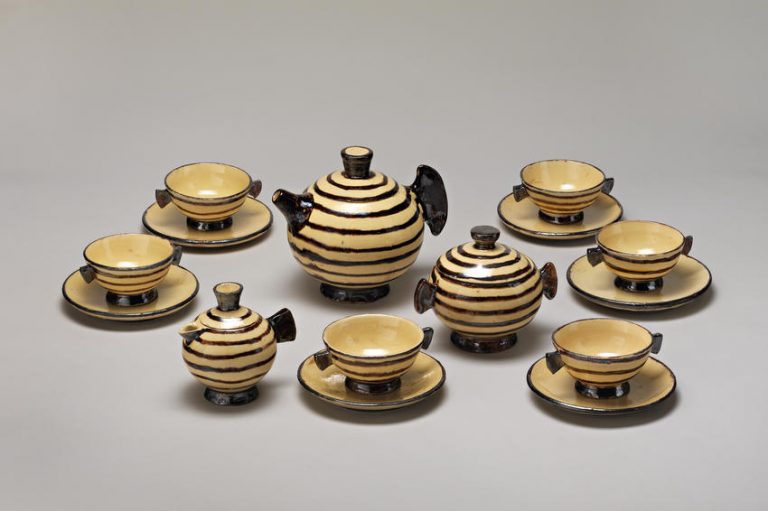We acknowledge the Traditional Owners of the land on which the Queensland Art Gallery | Gallery of Modern Art stands and recognise the creative contribution First Australians make to the art and culture of this country.

Anne Dangar / Australia/France 1885–1951 / Tea service c.1945–51 / Wood-fired glazed ceramic / Eighteen pieces: teapot with lid: 16 x 14cm (diam.) (complete); milk pot with lid: 12 x 9cm (diam.) (complete); sugar bowl with lid: 13 x 12cm (diam.) (complete); six cups: 5.5 x 10cm (diam.) (each); six saucers: 2 x 15cm (diam.) (each) / Purchased 2011 with funds from Margaret Mittelheuser, AM, and Cathryn Mittelheuser, AM, through the Queensland Art Gallery Foundation / Collection: Queensland Art Gallery | Gallery of Modern Art
Anne DangarTea service c.1945–1951
Not Currently on Display
Anne Dangar gave up painting to concentrate on pottery because she could not afford to buy proper painting materials. However, she soon came to prefer ceramics as a medium. Having learned traditional techniques from master potters in the Lyon region of France, she then taught them to the local children.
Dangar fused modernist design principles with traditional handmade methods to produce unique and inspired ceramic pieces, such as this tea service. The concentric circles suggest the elevating motif of the spiral — an emblem of Celtic cosmic symbolism.
In line with Albert Gleizes’s theories, Dangar drew on the iconography of ancient cultures, admired for its purity, which included Roman and Celtic styles. Like Gleizes, Dangar recognised the importance of craft and sought to create a unity between art, life and spirituality.
Born in Kempsey, New South Wales, Anne Dangar enrolled at Julian Ashton’s Sydney Art School in 1915, where fellow pupil Grace Crowley became a lifelong friend. In 1926, after completing their studies, the friends decided to travel to Europe to explore developments in modern art.
Most significant for Dangar was her discovery of the art and writing of cubist painter Albert Gleizes (1881–1953). Forced to return to Australia to find work, Dangar was dismayed to find little appreciation of the theories she now followed. In 1930, she accepted Gleizes’s invitation to join his community in France and immediately embraced its ideals of creativity and self-sufficiency. After the restrictions of World War Two were lifted, Dangar travelled extensively through the country, reactivating her commitment to the traditional pottery methods she hoped would be part of a revival of popular arts in both France and Australia.
Discussion Questions
1. What is Dangar communicating to audiences by using the spiral motif in her artwork?
2. How does a motif change its meaning when it is included in a functional design rather than a purely aesthetic artwork? Can a symbol have the same level of meaning in a decorative work as it does in an artwork?
Activities
1. Make a pinch pot or coil pot that imitates the rotund shape of Dangar’s forms in Tea service. Design a motif that means something to you (e.g. stripes to signify eternity, spots to signify happiness). Decorate your pot with your motif by painting or engraving it, or both.
2. Brainstorm, sketch and design a three-dimensional object that fits the following criteria: performs a function, is handheld, inspired by an element of architecture, and displays an iconic two-dimensional artwork on its surface. Use the final designs to reflect on the relationships between art, architecture, craft and design.